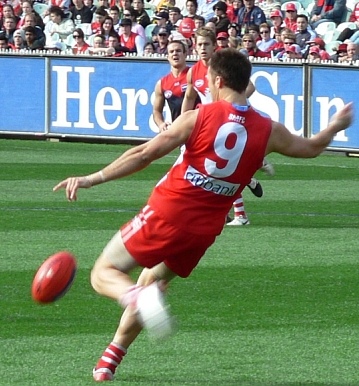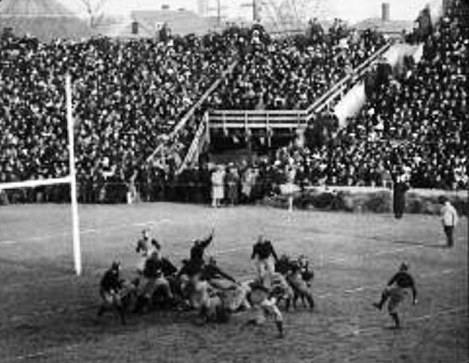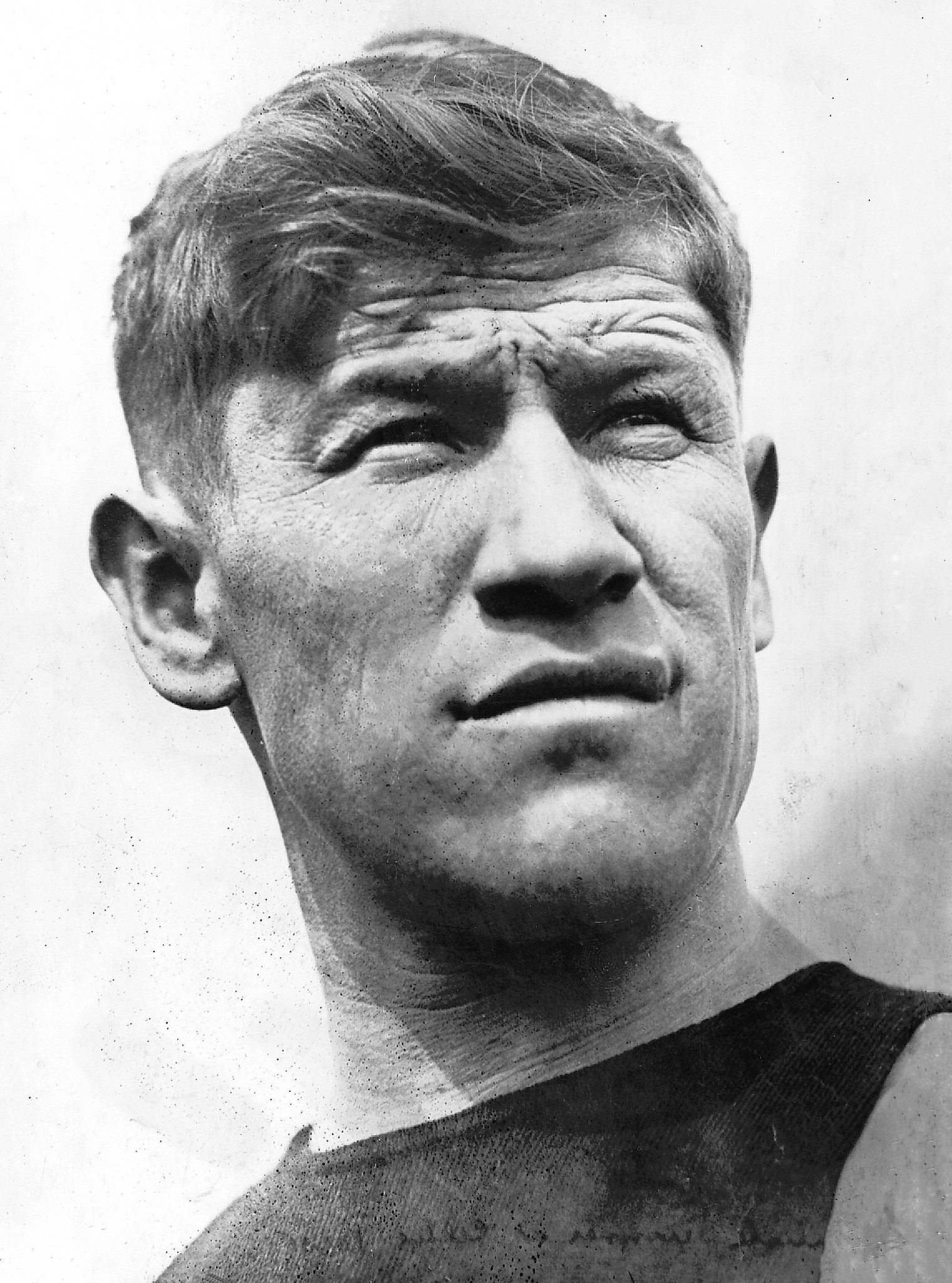|
Drop Kick
A drop kick is a type of kick in various codes of football. It involves a player dropping the ball and then kicking it as it touches the ground. Drop kicks are used as a method of restarting play and scoring points in rugby union and rugby league. Also, association football goalkeepers often return the ball to play with drop kicks. The kick was once in wide use in both Australian rules football and gridiron football, but is rarely used anymore by either sport. Rugby Drop kick technique The drop kick technique in rugby codes is usually to hold the ball with one end pointing downwards in two hands above the kicking leg. The ball is dropped onto the ground in front of the kicking foot, which makes contact at the moment or fractionally after the ball touches the ground, called the ''half-volley''. The kicking foot usually makes contact with the ball slightly on the instep. In a rugby union kick-off, or drop out, the kicker usually aims to kick the ball high but not a great di ... [...More Info...] [...Related Items...] OR: [Wikipedia] [Google] [Baidu] |
Paddy Driscoll
John Leo "Paddy" Driscoll (January 11, 1895 – June 29, 1968) was an American professional football and baseball player and football coach. A triple-threat man in football, he was regarded as the best drop kicker and one of the best overall players in the early years of the National Football League (NFL). He was inducted into the Pro Football Hall of Fame in 1965 and the College Football Hall of Fame in 1974. Driscoll played college football as a quarterback and halfback for the Northwestern football team in 1915 and 1916. In 1917, he played Major League Baseball as an infielder for the Chicago Cubs. He joined the United States Navy during World War I and played for the undefeated 1918 Great Lakes Navy football team that won the 1919 Rose Bowl. Driscoll played professional football as a quarterback and halfback for the Hammond All-Stars (1917), Hammond Pros (1919), Racine/Chicago Cardinals (1920–1925), and Chicago Bears (1926–1929). He was the NFL's first All-Pro quarte ... [...More Info...] [...Related Items...] OR: [Wikipedia] [Google] [Baidu] |
Kick (football)
Kicking is a skill used in many types of football, including: * American football *Association football * Australian rules football * Canadian football * Gaelic football *International rules football * Rugby league * Rugby union Kicking is the act of propelling a ball by striking it with the foot or, depending upon the sport, the shin. Kicking is most common in Association Football, where only the two goalkeepers are allowed to use their hands. It is also the primary method of transferring the ball in Australian rules football and Gaelic football. Whereas most sports allow points to be scored by methods other than kicking, in Australian rules football kicking for goal is the only method allowed to score a goal and get the maximum six point score. Kicking is used less frequently in Rugby League, Rugby Union, American football, and Canadian football, and may be restricted to specialist positions, but it is still an important tactical skill in each sport. List of common kick ... [...More Info...] [...Related Items...] OR: [Wikipedia] [Google] [Baidu] |
Fair Catch Kick
The fair catch kick is a rule at the professional and high school levels of American football that allows a team that has just made a fair catch to attempt a free kick from the spot of the catch. The kick must be either a place kick or a drop kick, and if it passes over the crossbar and between the goalposts of the opposing team's goal, a field goal, worth three points, is awarded to the kicking team. The fair catch kick is considered to be an obscure rule and it is rarely attempted. Because most fair catches are made well out of field goal range, and a team making a fair catch has possession of the ball and a first down, it is rarely to a team's advantage to attempt a fair catch kick rather than run a play from scrimmage. A team may attempt a fair catch kick if it makes a fair catch within reasonable range when the clock expires at the end of either half, as a half must be extended in order to allow a fair catch kick attempt. At the professional level, the last successful fair ... [...More Info...] [...Related Items...] OR: [Wikipedia] [Google] [Baidu] |
Al Bloodgood
Elbert "Al" Lorraine Bloodgood (September 5, 1901 – March 26, 1947) was a professional American football player in the National Football League (NFL). He played at the University of Nebraska. He graduated from Nebraska in 1924. He played five seasons in the NFL including the 1930 Green Bay Packers title team. Early life Al Bloodgood was born in Beatrice, Nebraska and attended Beatrice High School where became a Nebraska high school track state champion for the 100-yard dash in 1920, and the 440-yard dash and 880-yard relay in 1921. He graduated from high school in 1921. College football career Bloodgood attended DePauw University and then at the University of Nebraska-Lincoln where he earned varsity letters as a quarterback in 1923 and 1924. At Nebraska, he played during the tenure of head football coach Fred Dawson and alongside Ed Weir and Verne Lewellen. Bloodgood was a Cornhusker on the 1923 team that defeated Notre Dame University and head coach Knute Rockne's "Four Hors ... [...More Info...] [...Related Items...] OR: [Wikipedia] [Google] [Baidu] |
Frank Hudson (American Football)
Frank Hudson (1875 – December 24, 1950) was a football player and coach who was a member of the Laguna Pueblo tribe from New Mexico. He played college football for the Carlisle Indian Industrial School from 1895 to 1899 and was considered the greatest kicker in the early years of American football. In 1898, he became the first Native American player of the sport to be selected as an All-American. He was selected as a first-team All-American by ''Outing'' magazine in both 1898 and 1899. From 1904 to 1906, he served as an assistant coach of the Carlisle football team, becoming one of the first non-white coaches in college football history. Early years Hudson was born around 1875 in Paguate, New Mexico. His date of birth was unknown. He was a member of the Laguna Pueblo tribe. Carlisle Football player Hudson left his home and tribe in New Mexico to attend the Carlisle Indian Industrial School, an Indian boarding school in Carlisle, Pennsylvania, formed for the purpose o ... [...More Info...] [...Related Items...] OR: [Wikipedia] [Google] [Baidu] |
Charles Brickley
Charles Edward Brickley (November 24, 1891 – December 28, 1949) was an American football player and coach. He served as the head football coach at the Johns Hopkins University in 1915, at Boston College from 1916 to 1917, and at Fordham University in 1920 with Joseph DuMoe as co-coach, compiling a career college football record of 22–9. Brickley also coached the New York Brickley Giants of the American Professional Football Association—now the National Football League—in 1921, tallying a mark of 0–2. He also competed at the 1912 Summer Olympics. Early life and family Brickley was born in Boston, Massachusetts and raised in Everett, Massachusetts. He stood 5'10" and weighed 181 pounds during his athletic career. Athletic career Brickley attended Harvard College, where he played football from 1911 go 1914 for the Crimson as a fullback and placekicker under head coach Percy Haughton. He was named an All-American in 1913 and 1914. During the 1913 Harvard–Ya ... [...More Info...] [...Related Items...] OR: [Wikipedia] [Google] [Baidu] |
Lateral Pass
In gridiron football, a lateral pass or lateral (officially backward pass in American football and onside pass in Canadian football) occurs when the ball carrier throws the football to a teammate in a direction parallel to or away from the opponents' goal line. A lateral pass is distinguished from a forward pass, in which the ball is thrown forward, towards the opposition's end zone. In a lateral pass the ball is not advanced, but unlike a forward pass a lateral may be attempted from anywhere on the field by any player to any player at any time. While the forward pass is an invention of the North American games, the lateral and backward pass is also a part of rugby union and rugby league, where such passes are the norm. Compared to its use in rugby, laterals and backward passes are less common in North American football, due to a much greater focus on ball control in American football strategy; they are most commonly used by the quarterback, after taking the snap, to quickly tran ... [...More Info...] [...Related Items...] OR: [Wikipedia] [Google] [Baidu] |
Snap (football)
A snap (colloquially called a "hike", "snapback", or "pass from center") is the backward passing of the ball in gridiron football at the start of play from scrimmage. Action The ball begins on the ground with its long axis parallel to the sidelines of the field, its ends marking each team's line of scrimmage in American football; in Canadian football, the line of scrimmage of the team without the ball is 1 yard past their side of the ball. The player snapping the ball (known officially as the "snapper" in rule books) delivers the ball to another player, and that action is the snap. The snapper may hand, throw, or even roll the ball to the other player. The snap must be a quick and continuous movement of the ball by one or both hands of the snapper, and the ball must leave the snapper's hands. The various rules codes have additional requirements, all of which have the effect of requiring the ball to go backward. The snapper almost always passes the ball between his legs, but on ... [...More Info...] [...Related Items...] OR: [Wikipedia] [Google] [Baidu] |
Trick Play
A trick play, also known as a gadget play, gimmick play or trickeration, is a play in gridiron football that uses deception and unorthodox tactics to fool the opposing team. A trick play is often risky, offering the potential for a large gain or a touchdown if it is successful, but with the chance of a significant loss of yards or a turnover if not. Trick plays are rarely used not only because of the riskiness, but also to maintain the element of surprise for when they are used. Trick plays take advantage of defenses' expectations and conventional wisdom, the set of basic principles to which most offenses adhere. Most offenses follow a basic set of conventions in that once the ball is snapped to the quarterback, it seldom changes hands more than once: a hand-off or pitch to a running back, or a forward pass, and the players with the best skill sets for those particular plays are the ones that will execute them. For example, the quarterback is by far the best thrower on the field ... [...More Info...] [...Related Items...] OR: [Wikipedia] [Google] [Baidu] |
Newspapers
A newspaper is a periodical publication containing written information about current events and is often typed in black ink with a white or gray background. Newspapers can cover a wide variety of fields such as politics, business, sports and art, and often include materials such as opinion columns, weather forecasts, reviews of local services, obituaries, birth notices, crosswords, editorial cartoons, comic strips, and advice columns. Most newspapers are businesses, and they pay their expenses with a mixture of subscription revenue, newsstand sales, and advertising revenue. The journalism organizations that publish newspapers are themselves often metonymically called newspapers. Newspapers have traditionally been published in print (usually on cheap, low-grade paper called newsprint). However, today most newspapers are also published on websites as online newspapers, and some have even abandoned their print versions entirely. Newspapers developed in the 17th ... [...More Info...] [...Related Items...] OR: [Wikipedia] [Google] [Baidu] |
Jim Thorpe
James Francis Thorpe ( Sac and Fox (Sauk): ''Wa-Tho-Huk'', translated as "Bright Path"; May 22 or 28, 1887March 28, 1953) was an American athlete and Olympic gold medalist. A member of the Sac and Fox Nation, Thorpe was the first Native American to win a gold medal for the United States in the Olympics. Considered one of the most versatile athletes of modern sports, he won two Olympic gold medals in the 1912 Summer Olympics (one in classic pentathlon and the other in decathlon). He also played American football (collegiate and professional), professional baseball, and basketball. He lost his Olympic titles after it was found he had been paid for playing two seasons of semi-professional baseball before competing in the Olympics, thus violating the contemporary amateurism rules. In 1983, 30 years after his death, the International Olympic Committee (IOC) restored his Olympic medals with replicas, after ruling that the decision to strip him of his medals fell outside of ... [...More Info...] [...Related Items...] OR: [Wikipedia] [Google] [Baidu] |







